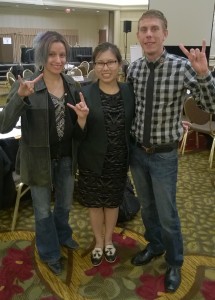Bible – Stage Manager’s script with all cues noted.
Bobtail – Short semi, a box truck used to transport stage equipment.
Boneyard – Where empty cases are stored.
Bounce – A thin and light colored drop used to “bounce” light off of.
Bring It In – Lower the pipe.
Buddy (Uncle Buddy) – Friction tool used on the fly rail to help control the movement of out-of-weight battens.
Bull Lines – Ropes pulled from the floor to assist the flyrail in overhauling heavily loaded battens.
Bump – To make an instantaneous lighting change or to quickly flash a light. Also, the command to make a tiny adjustment to a chain motor, either in or out.
Cable Stretcher – Tool used when you need just 6” more to make a connection. Rare.
Carpenter Focus – When the flyman nails lights on a pipe with an adjacent batten. Best when lights were focused.
Carptrician – Person who performs work which spans grey area between carpentry and electrics.
Coffee – A 15 minute break about two hours into a call in which stagehands eat as many donuts as they can.
Courtesy tab- End of a piece of tape that’s folded over and stuck to itself for easy removal.
Cyclorama (Cyc) – A curtain positioned upstage and sometimes concave to include stage sides. Used with lighting effects to create the illusion of sky or infinite space.
Dead – No longer in use.
Deck – Stage floor.
Dock – Place where post show socializing takes place.
Drop – Goods hung from the air, scenic element.
Ghost Light – Light left onstage after all work is over to keep the ghost company. Also a safety feature for humans.
Gobo – lit. “Go between optics.” A perforated piece of metal that alters the shape of a light beam, generally used in ellipsoidal fixtures. Also made of glass.
Goods – Fabrics suspended in air by battens, scenic elements.
Hod – Large cable loom.
House – Seating area in a theatre.
IA (IATSE) – International Alliance of Theatrical Stage Employees and Studio Mechanics.
Jesus bolt – Pan bolt on a c-clamp, sometimes referred to as a f*** nut
Kabuki – Special effect drop that falls swiftly to reveal talent/other dramatically
Leko – Ellipsoidal fixture in general, originally Lekolite introduced in 1933
Lightwalk – To be onstage as light levels are set. This is done so the designer can see light on people
Loom – Assortment of cables taped together at intervals to keep a long run cleaner and more manageable.
LX – Electrics
Main rag – Downstage most drape, hides whole stage from view
Merde – Pre-show good luck saying in ballet
Mouse – To use a piece of tie line, sash cord, or rope to secure something in place
Olio – A single (often painted) drop. Also, a short piece in between acts in a burlesque or minstrel show.
Overhaul – To bring heavy goods all the way in to the deck. Often requires assistance from loading rail and bull lines.
Parterre – Upper part of the main seating level
Phoning it in – Usually in reference to the talent half-assing a performance
Pigeon Plate – metal floor plate
Rep. (Repertory) – A space or company which performs several different plays alternately throughout the season. Also refers to lighting, staging, etc. which is used with minimal manipulation.
Ring out – To adjust equalization so as to eliminate monitor feedback; also older term for trouble-shooting electrics
Roadie – Technician who travels in support of a show/artist.
Rub – Assistance from the loading rail in pulling the purchase line which moves a heavy pipe.
Sheave – A wheel with a groove on its edge for holding a belt, rope or cable. Sometimes used synonymously with “pulley”.
Sitz (Sitzprobe) – German for seated rehearsal, often first rehearsal with talent and orchestra, sans blocking.
Sky hook – Special rigging tool that allows one to safety off to the sky.
Spark – To turn on a follow spot.
Sport bitching – What you hear around the water cooler.
Sprinkles – Optimal donut topping, especially on pink icing.
Strike – What you get when you knock down all the pins.
Take It Out – Raise the pipe.
Toi Toi Toi – Pre-show good luck saying in opera.
Tootsie Roll – While folding goods, the tendency for goods to roll up instead of folding cleanly.
Vomitorium – Exit from the house.
Wedge – A stage audio monitor.
West Coast – To gather a drop as it is lowered in, and to tie it in a bunch either to a pipe or truss, or to itself for storage.
Whoa – A word used while riding a horse.
Wilson – In cribbage a high point hand at the end of a game that you will never count.

